Under controlled conditions and using a full canister the Reactor boiled a liter of water in just less than three minutes (2:54) – so quickly it almost took me by surprise. Subsequent boils were nearly as quick, averaging 3:03 over five test boils. The Reactor has a built-in fuel pressure regulator, which provides steady output throughout the life of each canister. The Jetboil stoves didn’t live up to the speedy performance that their name implies. The GCS averaged 6:51 per liter boiled and the PCS averaged 6:44 per liter boiled (3:22 for its half-liter capacity), achieving low times of 6:20 and 6:37 per liter on a full canister, respectively. About the tests: All of our tests were performed using 69° F air and water temperatures. The stoves were fueled with an 80/20 Isobutane/Propane mix from 220-gram canisters and operated at maximum output. Fastest Boiling: MSR Reactor Fuel Efficiency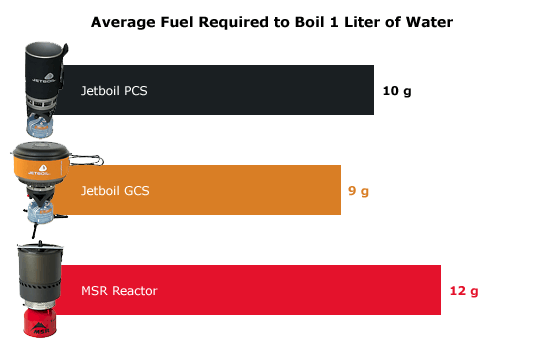
The Jetboil stoves were designed with efficiency foremost in mind. They feature burners that sip fuel at a decidedly slower rate than most canister stoves. Instead of blasting the pot with as much thermal energy as possible – and losing much of it up the sides – the Jetboil burner is calibrated so that the heat exchanger captures the stove’s energy before it escapes up the sides of the pot. This design makes the Jetboil stoves very fuel-efficient: in our tests the PCS and GCS averaged 10 grams and 9 grams of fuel, respectively, per liter boiled. That translates to 22 and 24 liters per 220-gram canister. The trade-off for this level of efficiency is in boil times (see above).
The Reactor takes a decidedly more high-output approach, relying on a beefy heat exchanger that extends up the sides of the pot to capture every last bit of heat. This results in very fast boil times, albeit using a bit more fuel than the Jetboil stoves. The Reactor consistently required 12 grams of fuel to boil one liter of water. That’s 18 boils per 220 g canister – not quite as stingy as the Jetboil GCS's 24 boils, but still better than traditional canister stove designs. Because of their efficient use of energy, all three stoves put off very little residual heat. No worries about singeing your hands while stirring these pots. Most Fuel-Efficient: Jetboil GCS Real-World Performance / WindMost stove tests are conducted under controlled laboratory conditions – conditions you’ll probably never replicate in the backcountry. But even a small breeze can have a big impact on a stove’s performance, sapping heat away from the pot and into the passing air, so we also conducted tests in an 8 mph wind. All three stoves’ heat exchangers help to shelter their burners from the wind, giving them a distinct advantage over traditional canister stove designs. But the Reactor is the only design that completely encloses the burner. In an 8 mph wind the Reactor boiled a liter of water in 3:16, just several seconds longer (and using no more fuel) than in calm conditions. The Jetboil PCS didn’t fair as well, taking a full minute longer (4:22 vs. 3:22) to boil its smaller half-liter cup. The Jetboil GCS performed poorly in the wind, needing 18:26 to boil a liter, and burning more than twice as much fuel to do so as in calm conditions. Thanks to their built-in piezo lighters, both Jetboil stoves are easy to light under windy conditions, while firing up the Reactor requires keeping a match or lighter going in the wind. This negates some of the Reactor’s advantage in the wind, but MSR plans on adding a piezo to future versions. We haven’t done cold-weather testing of these stoves, but the Reactor’s pressure regulator promises to maintain steady performance over a range of temperatures. Also in the real world, how you adjust your stove can have a big impact on efficiency and boil times. While we weren’t able to test every stove at every conceivable output level, the Reactor boiled a liter of water in 4:04 using just 10 grams of fuel at a medium setting. Best Real-World Performance: MSR Reactor Weight / PackabilityAt 15.3 ounces, the Jetboil PCS is the smallest and lightest integrated canister stove, but the tradeoff is that it has less than half the capacity of the Reactor and the Jetboil GCS. That’s okay if you’re traveling solo, but not so convenient when cooking for a crowd of hungry backpackers. For an additional 4.3 ounces (Jetboil GCS) or 4.6 ounces (MSR Reactor) you get a pot with nearly double the capacity. The Reactor is the heaviest stove of the three, due mostly to its beefy heat exchanger, but requires less pack space than the GCS. When sharing the load with a partner, carrying a GCS or Reactor is lighter than bringing an additional pot for the PCS. The Reactor and the Jetboil PCS are both designed so that their burners and fuel canisters (220 g canister in the Reactor, 100 g in the PCS) fit snugly inside their pots. The Jetboil GCS’s components also pack inside its pot, but the fit is loose, which can leave the pot support rattling annoyingly in your pack. Best for Weight and Packability: Jetboil PCS CompatibilityThe Jetboil GCS’s pot support allows you to use the Jetboil burner with almost any cookware, including frying pans and larger pots, although you’ll lose the advantage of the heat exchanger. Since the PCS and GCS use the same burner it’s also possible to mix-and-match Jetboil components for different trips, using the PCS pot for fast-and-light summit attempt or carrying the whole kit along for family backpacking. The Reactor is limited to using its single 1.4-liter pot. Because of the burner’s convex design, other pots cannot be placed on the Reactor. MSR has not announced plans for any additional Reactor-compatible cookware. Most Compatible: Jetboil GCS CookingBoth the Reactor and the Jetboil PCS are designed primarily for boiling water and melting snow. Their deep, narrow pots are awkward to stir without an extra-long spoon, and are not particularly conducive to preparing haute cuisine. Neither is compatible with other cookware, so frying up breakfast pancakes is impossible. I did manage to cook a packaged rice and chicken meal in the Reactor, but stirring and eating out of the deep pot was awkward at best. For the most part with the Reactor and Jetboil PCS you’ll want to stick to boiling water for drinks and freeze-dried meals. The GCS’s more conventionally sized pot makes it a better candidate for culinary tasks that require more than boiling water. The GCS pot has measurements stamped (legibly!) into the pot at the 0.5-, 1.0-, and 1.5-liter marks – which can simplify boiling and cooking tasks and eliminate the need for measuring via a water bottle. And the Jetboil’s lower-output burner makes simmering with the GCS a better proposition than with many canister stoves. Best for Cooking: Jetboil GCS Ease of UseThe Reactor has the fewest parts: pot, lid, burner, and fuel canister. The PCS adds a protective cover for its heat exchanger, the cover doubling as a small measuring cup. Both stoves allow you to store the stove with the burner and canister still connected to each other, which saves time and hassle both before and after a meal or a quick brew. Packing up the GCS requires separating the components and arranging them just so inside the pot. The Reactor’s rugged Lexan lid sits nicely on top of the pot without having to be “snapped” on or off like those on the Jetboils. However, I found that the surface tension of collected condensation tends to “seal” the Reactor’s lid to the rim of the pot when boiling water – making it very difficult to pry off when it’s still hot. The curved design and protruding handle of the Reactor’s lid also makes it pretty much useless for anything other than covering the pot. The GCS’s plastic lid and heat exchanger cover, on the other hand, can double as plates, cutting boards, or shallow bowls. Like most canister stoves, a small knob built into the body of the stove regulates output of the Jetboil GCS and PCS. The plastic knob stays cool to the touch, but its recessed location can make it awkward to adjust, especially with gloves on. The Reactor's adjustment knob is located in a somewhat more accessible location, on the outside of the burner body. (Our test Reactor featured a large plastic throw lever that did not make it into the production version.) Since the Reactor is very quiet and the pot completely encases the burner, you have to lift the pot off the burner to tell if it’s still lit; several times I extinguished the burner while attempting to simmer. One unique feature of the Jetboil PCS is that the burner securely latches to the pot. By clipping the pot’s nylon webbing handle to a carabiner, the PCS can easily be rigged into a hanging setup favored by big wall climbers. Neither the GCS nor the Reactor is so equipped. The GCS requires special care when removing the pot. If you try to slide the pot off the stove rather than lifting straight up, the heat exchanger can catch on the pot support and dislodge it or upset the entire stove. Easiest to Use: MSR Reactor and Jetboil PCS (tie) ConclusionThe MSR Reactor, the Jetboil PCS, and the Jetboil GCS are all solid performers and each has something unique to offer. Which stove is the best will depend on your specific needs. If you often travel solo and are looking to cut your pack weight, the Jetboil PCS is the obvious choice. Its diminutive size and miserly fuel consumption make it handy for brewing a quick trailside cup of tea. Used with smaller 110 g fuel canisters, it packs down small and saves weight on shorter trips, but may not make sense if you’re traveling with a group. For boiling water quickly or melting snow in windy conditions, the MSR Reactor gets the job done. It’s the heaviest (by only 0.3 oz.) and least fuel-efficient of the three stoves tested, but by far the best performer in a variety of conditions. And don’t overlook the “gee-whiz” factor – the Reactor’s unique design will get some stares wherever you light it up. If you’re cooking for a group or want to get more creative than freeze-dried meals, the Jetboil GCS is the best bet, but beware its lack of performance in the wind. Combined with a PCS pot (aka Jetboil Companion Cup, available separately) the GCS can provide flexibility for a variety of trips. | 





 发表于 2007-6-18 23:02
|
发表于 2007-6-18 23:02
| 









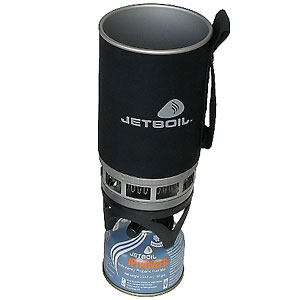
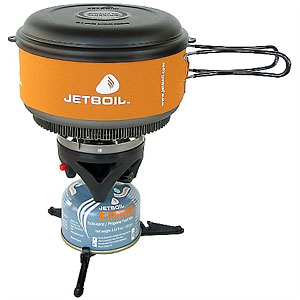
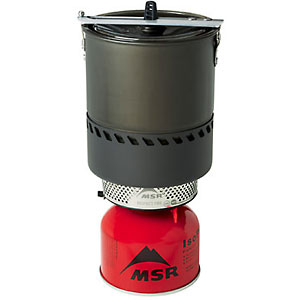
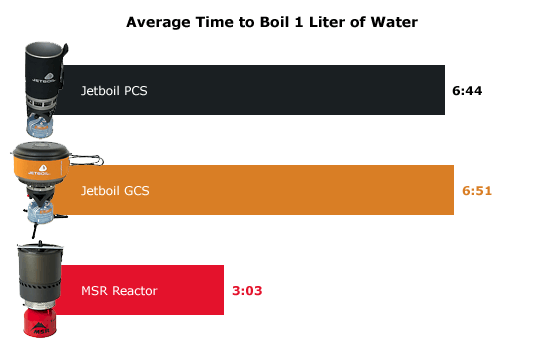

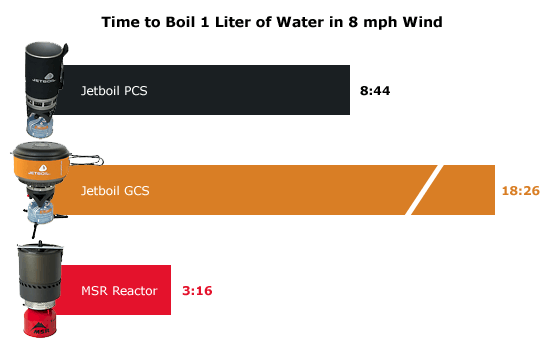
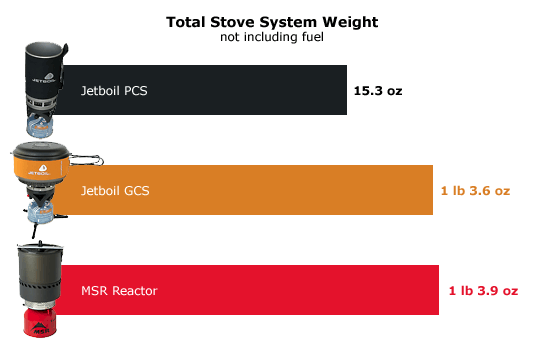

 发表于 2014-5-24 10:36
|
发表于 2014-5-24 10:36
| 
